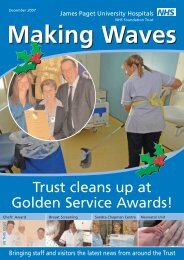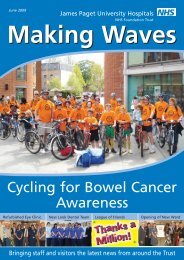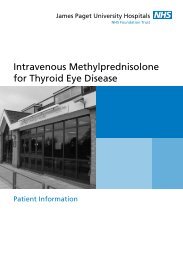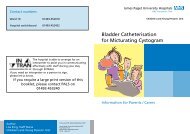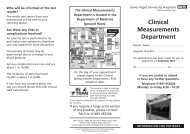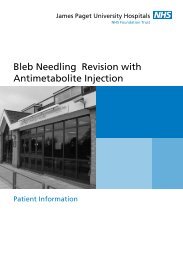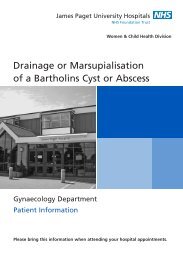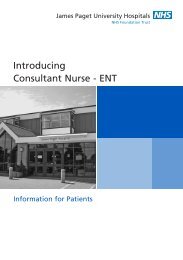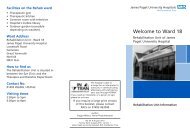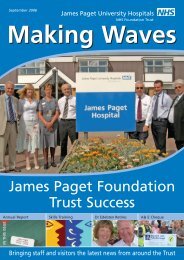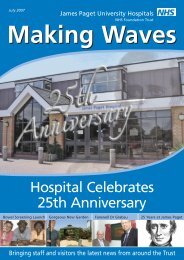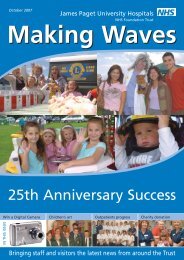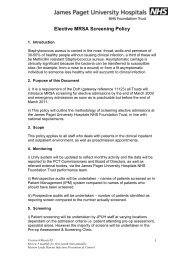Making Waves June 2011 - James Paget University Hospitals
Making Waves June 2011 - James Paget University Hospitals
Making Waves June 2011 - James Paget University Hospitals
Create successful ePaper yourself
Turn your PDF publications into a flip-book with our unique Google optimized e-Paper software.
<strong>James</strong> <strong>Paget</strong> <strong>University</strong> <strong>Hospitals</strong><br />
NHS Foundation Trust<br />
Transformation Update<br />
The six work streams are making real progress, along with some of the supporting projects. The list is not exhaustive, and<br />
new ideas for projects are always welcomed by the Transformation Board.<br />
Work Stream 1: Improving the in-patient pathway<br />
This incorporates the Length of Stay project, the primary goal of which is to achieve and maintain a reduction of 30,000 bed<br />
days across the Trust’s combined elective and non-elective in-patient programme. Achieving this reduction should help the<br />
Trust to make optimal use of its existing bed capacity, and create the stability in which to strategically plan future in-patient<br />
services and provision.<br />
Work Stream 2: Improving the out-patient pathway<br />
This seeks to reduce DNA rates, improve first to follow-up ratios, and the productivity and cost effectiveness of outpatient<br />
services. The first phase of the DNA project is to reduce the Trust-wide DNA (Do Not Attends) to 4%, with the second phase<br />
focusing on reducing this rate to 2.5%, which will lead to savings in excess of £0.5million.<br />
Work Stream 3: Procurement<br />
The procurement work stream focuses on reducing all procurement-influenced non-pay expenditure by around<br />
12.5%. The project team will therefore be seeking savings from a combination of approaches, including<br />
achieving better prices with suppliers, maximising the opportunities for recovering VAT, raising price<br />
awareness amongst all staff groups, improving stock control and reducing waste.<br />
Work Stream 4: Reducing Locum, Agency and overtime spend<br />
This incorporates several projects, including e-rostering and reducing agency/locum.<br />
The overall goal is to achieve greater value for money in respect of pay costs,<br />
e.g. by reducing the Trust’s reliance on costly agency or locum staff.<br />
Work Stream 5: Doing More for Less<br />
This incorporates many subsidiary projects, including:<br />
• A review of pharmacy services, and bringing FP10s in-house;<br />
• A radiology review, including demand management;<br />
• A pathology review, including demand management;<br />
• A review of catering and domestic services;<br />
• A review of ward-based roles, to improve essential patient care;<br />
• A project aimed at maximising income from better use of Trust<br />
infrastructure.<br />
Work Stream 6: Patient Safety, Patient Experience and<br />
CQUINs<br />
This continues to build on the foundation of work that was<br />
commenced in 2010/11 to improve patient safety, enhance the<br />
patient experience, and to achieve quality-related income targets.<br />
New Patient Appointment Reminder Service<br />
Patients who fail to arrive for appointments, known as Did Not Attends (DNAs), are costing<br />
For every appointment missed, the hospital loses income. Therefore a new system is being<br />
piloted in three clinical areas – Ophthalmology, Orthopaedics and ENT (ear, nose and throat) to send<br />
reminders to patients of their impending appointment. The aim is to improve efficiency, reduce the<br />
number of DNAs and provide advanced notification of cancellations and rearrangements so these<br />
appointments can be refilled.<br />
An automated call will play a message asking the patient to confirm they are the patient<br />
mentioned by pressing the number 1 on their keypad. This will be checked by asking them to enter<br />
their date of birth. As long as this date of birth matches our records the message will continue to<br />
tell them their appointment details and ask them to press the appropriate number on the keypad<br />
to confirm, cancel or rearrange their appointment.<br />
Reducing the number of DNAs can make a significant difference in reducing the number of<br />
wasted appointments which could be filled by other patients. The anticipated reduction in the<br />
number of DNAs will make this investment cost-effective in the long term.<br />
www.jpaget.nhs.uk<br />
www.jpaget.nhs.uk <strong>Making</strong> <strong>Waves</strong> Newsletter <strong>June</strong> <strong>2011</strong> Page 9



